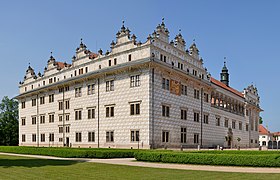
Back الهندسة المعمارية التشيكية في عصر النهضة Arabic Renesanční architektura v Česku Czech Arquitectura renacentista checa Spanish Arquitetura renascentista na Tchéquia Portuguese Чешка ренесансна архитектура Serbian Kiến trúc Phục hưng Séc Vietnamese


Czech Renaissance architecture refers to the architectural period of the early modern era in Bohemia, Moravia and Czech Silesia, which then comprised the Crown of Bohemia and today constitute the Czech Republic. The Renaissance style flourished in the Czech lands from the late 15th century to the first half of the 17th century.[1]
In the Crown of Bohemia as well as in other parts of Central Europe the Renaissance style was accepted slower than in southern Europe and its development was delayed in comparison with Italy. It was partly caused by the situation in the Kingdom after the Hussite Wars. The Bohemian Reformation was mistrustful of the influences coming from the "papal" Italy and rather respected the traditional values expressed with the older Gothic style. Therefore, the first examples of the Renaissance architecture in the Czech lands can be found in the domains of the Catholic aristocracy or the Catholic king. The Renaissance style first appeared in the Czech Kingdom in the 1490s. Bohemia (together with its incorporated lands, especially Moravia) thus ranked among the areas of the Holy Roman Empire with the earliest known examples of the Renaissance architecture.[2]
The lands of the Bohemian Crown were never part of the ancient Roman Empire, thus they missed their own ancient classical heritage and had to be dependent on the primarily Italian models. As well as in other Central European countries the Gothic style kept its position especially in the church architecture. The traditional Gothic architecture was considered timeless and therefore able to express the eternity of God or to emphasize the long tradition of the place where it was used. The Renaissance architecture coexisted with the Gothic style in Bohemia and Moravia until the late 16th century (e. g. the residential part of a palace was built in the modern Renaissance style but its chapel was designed with Gothic elements).
The facades of Czech Renaissance buildings were often decorated with sgraffito (figural or ornamental). The figural sgraffito as well as relief decorations usually drew inspiration from the Bible or ancient mythology.
- ^ Černá, Marie (2012). Dějiny výtvarného umění. Praha: Idea Servis. pp. 91–93. ISBN 978-80-85970-74-6.
- ^ Hamlin, Alfred D. (2010). History of architecture. Bremen: Salzwasser-Verlag. p. 338. ISBN 9783861952503.
© MMXXIII Rich X Search. We shall prevail. All rights reserved. Rich X Search